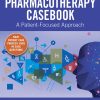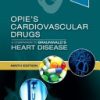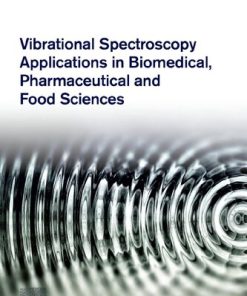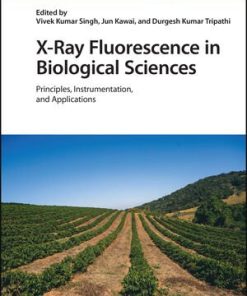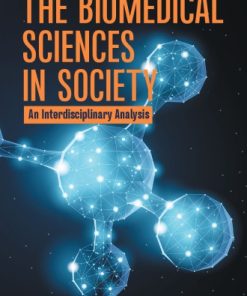(EBook PDF) Principles of Biomedical Sciences and Industry 1st edition by Markus Hinder, Alexander Schuhmacher, Jorg Goldhahn, Dominik Harti 3527824006 9783527824007 full chapters
$50.00 Original price was: $50.00.$25.00Current price is: $25.00.
Principles of Biomedical Sciences and Industry 1st edition by Markus Hinder, Alexander Schuhmacher, Jorg Goldhahn, Dominik Harti – Ebook PDF Instant Download/DeliveryISBN: 3527824006, 9783527824007
Full download Principles of Biomedical Sciences and Industry 1st edition after payment
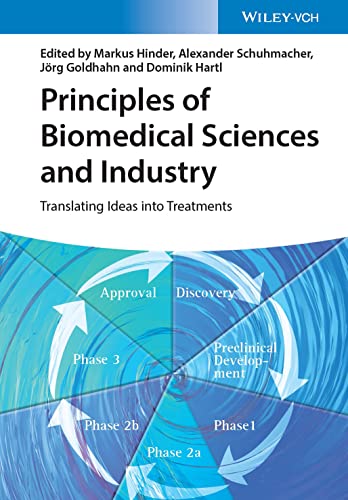
Product details:
ISBN-10 : 3527824006
ISBN-13 : 9783527824007
Author: Markus Hinder, Alexander Schuhmacher, Jorg Goldhahn, Dominik Harti
Principles of Biomedical Sciences and Industry Improve your product development skills to bring new ideas to biomedicine The development of innovative healthcare products, such as biodegradable implants, biopharmaceuticals, or companion diagnostics, requires a multi-disciplinary approach that incorporates scientific evidence with novel and innovative ideas to create new and improved products and treatments. Indeed, product development and the integration of science with commercial aspects have become key challenges for scientists working in the pharmaceutical, biotech, and medtech industries. Using a multi-pronged approach to development, Principles of Biomedical Sciences and Industry combines ideas and methodologies from four of the central areas of focus in the biomedical arena: pharmaceuticals, diagnostics, biomaterials, and medical devices. In doing so, the book covers the entire product lifecycle, from translating a scientific idea into a prototype to product development, launch, and management. Principles of Biomedical Sciences and Industry readers will also find: Several case studies from the most important product categories (pharmaceuticals, diagnostics, medical devices, combination products) Chapters dealing with toxicology and safety risks in development, as well as regulatory approval Key business aspects including how to secure funding, managing intellectual property, and price regulation in the market An ideal resource for teachers and students that conveys the information in an easily-digestible format Ideal for advanced students and young professionals pursuing a career in the biomedical and healthcare industries, Principles of Biomedical Sciences and Industry is an essential reference for those in pharmaceutical industry, biotechnologists, medicinal chemists, bio-engineers, pharma engineers, and management consultants.
Principles of Biomedical Sciences and Industry 1st Table of contents:
1 Biopharmaceutical Innovation at a Glance
Summary
1.1 Biopharmaceutical Innovation and Drug Development, the Past and Present
1.2 Why We Wrote This Book and What Readers Can Expect to Gain from Reading It
References
2 Pharmacology and Drug Targets – The Basis of Therapeutics
Summary
2.1 Introduction
2.2 Pharmacodynamics
2.3 Receptors and Ion Channels
2.4 Receptor Agonism and Antagonism
2.5 Implications for Drug Development
2.6 Pharmacokinetics
2.7 Quantitative Pharmacokinetics
2.8 Pharmacokinetic Models
2.9 Implications for Drug Development
2.10 Conclusions
References
3 Principles and Methods of the Pharmaceutical Drug Discovery Process – From Idea over Target to a Development Candidate
Summary
3.1 What is the Purpose of Drug Discovery?
3.2 Phases of the Drug Discovery Process
3.3 Target Identification
3.4 Strategies to Modulate Biological Targets
3.5 The Lead Identification Process
3.6 Strategies to Identify Lead Compounds
3.7 Drug Candidates
3.8 Outlook
References
4 Biomarkers: Definitions and Utility for Drug Development
Summary
4.1 Introduction
4.2 Biomarker Modalities
4.3 Biomarkers in Drug Development
4.4 Biomarker Use Cases
4.5 Outlook
References
5 Toxicology in Drug Development – Understanding a Drug’s Toxicity and Managing Safety and Risks
Summary
5.1 Introduction to Toxicology and Definitions
5.2 The General Toxicological Framework
5.3 The Concept of the Therapeutic Index
5.4 The International Regulatory Framework for Safety Evaluations
5.5 Animal Species Selection
5.6 Basic Concepts for Non‐clinical Studies to Support Clinical Trials
5.7 What Activity at Which Stage of Development?
5.8 Estimating the Safe Starting Dose in FIH Trials
5.9 Toxicological Evaluations During Late‐Stage Drug Development
5.10 Outlook
References
6 Introduction to Chemistry Manufacturing and Controls – From Compound and Development Candidate to Drug
Summary
6.1 CMC Introduction and Background
6.2 Some Basic Thoughts
6.3 Preclinical Development and the Clinical Phase 1 from a CMC Perspective
6.4 Preclinical Development and the Clinical Phase 2 from a CMC Perspective
6.5 Preclinical Development and the Clinical Phase 3 from a CMC Perspective
6.6 The Compilation and Authoring of the Submission Dossier for Marketing Authorization
6.7 The NDA Submission and the Steps to Product Launch
References
7 Translational Medicine – The Bridging Discipline. Role and Tools in the Drug Development Process
Summary
7.1 Translational Medicine, Definitions and History
7.2 The Translational Gap
7.3 Paths of Translation
7.4 Translational Medicine in Drug Development
7.5 Serendipity
7.6 Conclusions
References
8 Decision‐Making: What are the Key Drivers Around Decision‐Making in Drug Development?
Summary
8.1 Background
8.2 Key Decision Points
8.3 Moving Towards ‘Go IND Enabling’
8.4 Moving Towards Go/No Go First in Human (FIH)
8.5 Moving Towards Go/No Go Phase 2
8.6 Moving Towards Go Confirmatory Development
8.7 Concluding Remarks
References
9 Clinical Drug Development – Clinical Characterization for Regulatory Approval
Summary
9.1 Clinical Drug Development, Definition, and Framework
9.2 The Different Stages of Clinical Development
9.3 The Basic Framework and Elements for Clinical Trials
9.4 The Clinical Study Protocol
9.5 Written Subject Information
9.6 Graphical Study Design and Schedule of Activities
9.7 Definition of Patient Population and Sample Size Calculation
9.8 Study Design
9.9 General Methods and Statistical Tools
9.10 Target Product Profile, Clinical Development Plan, and Other Documents During Development
9.11 Changing Environment: Sensors, Digitalization, and COVID‐19 Pandemic
9.12 Key Studies During Clinical Development
9.13 Advisory Boards, Steering Committees, Data and Safety Monitoring Boards
9.14 Summary of Information
References
10 Regulatory Affairs – Communicating with Health Authorities
Summary
10.1 Regulatory Environment – Getting Started
10.2 The Role of Regulatory Affairs in Early Drug Development
10.3 The Common Technical Document
10.4 Investigational New Drug
10.5 Clinical Trial Application
10.6 Early Consultations with Health Authorities
10.7 Regulatory Requirements for Paediatric Diseases
10.8 Regulatory Pathways for Drug Development for Orphan/Rare Diseases
10.9 Accelerated Pathways for Expedited Clinical Development and Regulatory Review
10.10 The Role of Regulatory Affairs in Late‐Stage Drug Development
10.11 The Role of Regulatory Affairs Before, During and After Registration
10.12 Pre‐submission Meetings with Health Authorities
10.13 Additional Submission‐Enabling Regulatory Affairs Activities
10.14 Health Authority Review of Registration Dossiers
References
11 Regulatory Affairs in Device Development – How to Design Medical Devices Capable to Enter the Market
Summary
11.1 Introduction
11.2 Product Commercialization
11.3 Ten Things to Know and Consider When Developing a Device
11.4 Obtaining Qualified Input from Interested Parties
11.5 Planning and Executing All Important Development Milestones
11.6 Design and Development Verification: Did I MAKE the Product Right?
11.7 Design and Development Validation: Did I MAKE the Right Product?
References
12 Market Entry and Reimbursement: Making Drugs Available for Patients After Drug Approval
Summary
12.1 Introduction
12.2 Healthcare Challenges
12.3 What Does Market Access Mean?
12.4 Market Access Gatekeepers
12.5 Drug Purchasing
12.6 Payers and Value Assessment
12.7 Health Economics as a Decision Tool for Market Access
12.8 Setting the Right Price
12.9 How Does the Pharma Industry Prepare for Market Entries?
12.10 Early Patient Access
12.11 Managed Entry Agreements
12.12 Market Access Trends
12.13 Future Market Access Challenges
References
Note
13 Pricing in Germany – Key Learnings for Optimizing Price Potential After the Introduction of AMNOG
Summary
13.1 Introduction
13.2 Structure of the Pricing and Reimbursement Process in Germany
13.3 Analysis of Effects of the AMNOG Process on Drug Prices in Germany
13.4 Learnings from AMNOG to Ensure Success in the German Market
13.5 Study Design
13.6 Dossier Preparation
13.7 Pre‐launch Strategy
13.8 Post‐launch
13.9 Price Negotiation
13.10 Post‐negotiation
13.11 Key Takeaways
Key Resources
References
14 Project, Risk, and Portfolio Management – Managing R&D Projects Today*
Summary
14.1 Introduction
14.2 The Phases of the Pharma R&D Process
14.3 Projects and Project Management
14.4 Project Life Cycle and Project Phases
14.5 Risk Management
14.6 Portfolio Management
References
Note
15 Intellectual Property – How to Protect Innovation in the Biopharmaceutical Industry
Summary
15.1 Introduction to Intellectual Property Rights
15.2 Patent Rights
15.3 The ‘Freedom to Operate’ Principle
15.4 Intellectual Property Protection in the Biopharmaceutical Industry
15.5 Conclusion
16 Patents in the Biomedical Sciences and Industry – The Case of the Swiss Life Science Company Prionics
Summary
16.1 Patents in the Biomedical Sciences and Industry
16.2 The Swiss Life Science Company Prionics
16.3 Success Factors and Failures
16.4 Consequences and Insights
Key Resources
References
Note
17 Pharmaceutical Business Development and Licensing – Overview of a Cross‐Functional and Multifaceted Role and Its Key Elements in Biopharmaceutical Industry
Summary
17.1 Introduction
17.2 Types of Collaborations
17.3 Licensing Agreements
17.4 Commercial or Distribution Partnerships
17.5 Research Collaborations
17.6 Other Types of Agreements
17.7 Tech Transfer Agreements
17.8 Structured Approach – How to Start a Transaction?
17.9 Evaluation Process
17.10 Due Diligence
17.11 Letter of Intent and Term Sheet
17.12 Negotiation and Contract Closure
17.13 Alliance Management
17.14 Conclusions
References
18 The Entrepreneur’s Guide Through the Galaxy of Biotech Funding
Summary
18.1 Introduction
18.2 Seed Funding – from a Research Concept to Validation of a Business Idea
18.3 Getting Serious – Series A
18.4 Getting more Serious – Series B
18.5 Venture Debt as an Alternative to a Series B
18.6 Getting most Serious – Series C
18.7 Exit Options
18.8 Closing Remarks
Reference
19 Medical Technologies – Key Learning from Two Case Studies
19.1 Case Study 1 – Medical Grade Plastics (MPG)
19.2 Case Study 2 – Vitrectomy Using Fast Pneumatic‐Driven Cutter Systems
19.3 Innovative Valve Technology
19.4 Integration Technology
Note
20 Laboratory Diagnostics – Tools for Clinical Decision‐Making and Clinical Trial Endpoints
Summary
20.1 Definition of Diagnostics, Why Diagnostics, Importance of Diagnostics, Sample Types
20.2 The Diagnostics Industry – Key Figures and Key Players
20.3 Brief History of Diagnostics
20.4 Elements of the Laboratory Workflow (Pre‐analytics, Analytics, and Post‐analytics)
20.5 Various Types of Diagnostic Tests in the Laboratory
20.6 Place of Diagnostics in the Clinical Workflow
20.7 Quality Management
20.8 Regulatory Approval of Diagnostics
20.9 The Diagnostics R&D Process – Stage Gate and Agile Development Processes
20.10 The Future of Diagnostics – Key Technologies and Trends, Personalized Diagnostics
20.11 Conclusions
References
21 Vaccination: Towards an Improved Influenza Vaccine
Summary
21.1 Influenza – A Deadly Disease with a Long History
21.2 The Annual Challenge
21.3 Mechanisms of the Immune Response
21.4 Antigen Content
21.5 Although Influenza Vaccine Formulation Evolves to Reflect the Circulating Strains, Innovation is Rare
21.6 Medical Rationale for Intradermal Administration (ID)
21.7 Search for Greater Acceptability
21.8 Acceptability of the New Device
21.9 Acceptability in Real Life
21.10 Outlook and Trends
People also search for Principles of Biomedical Sciences and Industry 1st:
principle of biomedical science
principles of biomedical science high school
principles of biomedical science topics
principles of biomedical science quizlet
principles of biomedical science unit 1
Tags:
Principles,Biomedical Sciences,Industry,Markus Hinder,Alexander Schuhmacher,Jorg Goldhahn,Dominik Harti
You may also like…
Forensic Science
Uncategorized
Science (General)
Vibrational Spectroscopy Applications in Biomedical, Pharmaceutical and Food Sciences 1st Edition
Uncategorized
Politics & Philosophy
Cookbooks
Science (General)
Ambient Ionization Mass Spectrometry in Life Sciences: Principles and Applications 1st edition


